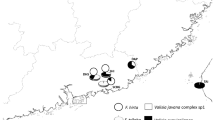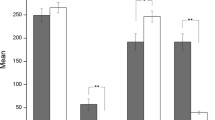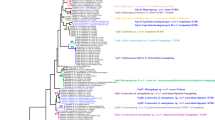Abstract
In the obligate mutualism between figs (Ficus) and their specific pollinators (Chalcidoidea, Agaonidae), each species of fig wasp typically reproduces in figs of a single host species. Host specificity is maintained largely because pollinators are attracted to tree-specific volatiles released from their host figs, but whether the wasps can reproduce if they enter figs of non-host species is unclear. We investigated the reproductive success of Ceratosolen emarginatus (associated with Ficus auriculata) and Ceratosolen sp. (associated with F. hainanensis) in atypical hosts by experimentally introducing foundresses into host and non-host figs. F. auriculata figs entered by Ceratosolen sp. were more likely to abort than if entered by C. emarginatus, but abortion of F. hainanensis figs was not affected by pollinator species. Single C. emarginatus foundresses produced more but smaller offspring in F. hainanensis than in their normal host. Conversely Ceratosolen sp. produced fewer but larger offspring in F. auriculata than in their normal host, probably as a result of having longer to develop. Mean style length differences, relative to the lengths of the wasps’ ovipositors, may have dictated the number of offspring produced, with oviposition made easier by the shorter styles in F. hainanensis figs. Our results imply that, in addition to morphological constraints and tree-specific volatiles, reduced reproductive success in atypical hosts can be another factor maintaining host specificity, but for other species only behavioural changes are required for host switching to occur.


Similar content being viewed by others
References
Berg CC (1989) Classification and distribution of Ficus. Experientia 45:605–611
Berg CC, Corner EGH (2005) Moraceae—Ficus. In: Nooteboom HP (ed) Flora Malesiana, vol 17 part 2. National Herbarium Nederland, Leiden, pp 340–347
Bezemer TM, Harvey JA, Mills NJ (2005) Influence of adult nutrition on the relationship between body size and reproductive parameters in a parasitoid wasp. Ecol Entomol 30:571–580
Chen C, Song Q (2008) Responses of the pollinating wasp Ceratosolen solmsi marchali to odor variation between two floral stages of Ficus hispida. J Chem Ecol 34:1536–1544
Compton SG, Holton KC, Rashbrook VK, van Noort S, Vincent SL (1991) Studies of Ceratosolen galili, a non-pollinating agaonid fig wasp. Biotropica 23:189–194
Compton SG, Grehan K, van Noort S (2009) A fig crop pollinated by three or more species of agaonid fig wasps. Afr Entomol 17:215–222
Cook JM, Rasplus JY (2003) Mutualists with attitude: coevolving fig wasps and figs. Trends in Ecol Evol 18:241–248
Cook JM, Segar ST (2010) Speciation in fig wasps. Ecol Entomol 35:54–66
Corner EGH (1967) Ficus in Solomon islands and its bearing on post-Jurassic history of Melanesia. Philos T R Soc B 253:23–34
Galil J, Eisikowitch D (1969) Further studies on the pollination ecology of Ficus sycomorus L. Tijdschr Entomol 112:1–13
Gross D (2008) Mountain pine beetle fecundity and offspring size differ among lodgepole pine and whitebark pine hosts. Utah State University, Dissertation
Haine ER, Martin J, Cook JM (2006) Deep mtDNA divergences indicate cryptic species in a fig-pollinating wasp. BMC Evol Biol 6:83
Harrison RD (2005) Figs and the diversity of tropical rainforests. Bioscience 55:1053–1064
Harrison RD, Yamamura N (2003) A few more hypotheses for the evolution of dioecy in figs (Ficus, Moraceae). Oikos 100:628–635
Herre EA (1989) Coevolution of reproductive characteristics in 12 species of new world figs and their pollinator wasps. Experientia 45:637–647
Herre EA, Jander KC, Machado CA (2009) Evolutionary ecology of figs and their associates: ongoing progress and outstanding puzzles. Ann Rev Ecolog Syst 39:439–458
Hossaert-McKey MM, Gibernau M, Frey JE (1994) Chemosensory attraction of fig wasps to substances produced by receptive figs. Entomol Exp Appl 70:185–191
Janzen DH (1979) How to be a fig. Annu Rev Ecol Syst 10:13–51
Kerdelhue C, Le Clainche I, Rasplus JY (1999) Molecular phylogeny of the Ceratosolen species pollinating Ficus of the subgenus Sycomorus sensu stricto: biogeographical history and origins of the species-specificity breakdown cases. Mol Phylogenet Evol 11:401–414
Kissling WD, Rahbek C, Böhning-Gaese K (2007) Food plant diversity as broad-scale determinant of avian frugivore richness. Proc R Soc B 274:799–808
Liu C, Yang DR, Peng YQ (2011) Body size in a pollinating fig wasp and implications for stability in a fig-pollinator mutualism. Entomol Exp Appl 138:249–255
Machado CA, Robbins N, Gilbert MTP, Herre EA (2005) Critical review of host specificity and its coevolutionary implications in the fig/fig-wasp mutualism. Proc Natl Acad Sci 102:6558–6565
Mackauer M, Sequeira R, Otte M (1997) Growth and development in parasitoid wasps: adaptation to variable host resources. In: Detter K, Bauer G, Volkl W (eds) Vertical food web interactions. Springer, Berlin, pp 191–203
Michaloud G, Carriere S, Kobbi M (1996) Exceptions to the one: one relationship between African fig trees and their fig wasp pollinators: possible evolutionary scenarios. J Biogeogr 23:513–520
Moe AM, Rossi DR, Weiblen GD (2011) Pollinator sharing in dioecious figs (Ficus: Moraceae). Biol J Linn Soc 103:546–558
Molbo D, Machado CA, Sevenster JG, Keller L, Herre EA (2003) Cryptic species of fig-pollinating wasps: implications for the evolution of the fig–wasp mutualism, sex allocation, and precision of adaptation. Proc Natl Acad Sci 100:5867–5872
Nefdt RJC, Compton SG (1996) Regulation of seed and pollinator production in the fig–fig wasp mutualism. J Anim Ecol 65:170–182
Rasplus JY (1996) The one-to-one species specificity of the Ficus–Agaoninae mutualism: how casual. In: van der Maesen LJG, van der Burgt XM, van MedenbachdeRooy JM (eds) The biodiversity of African plants. Kluwer Academic, Wageningen, pp 639–649
Santisuk T, Larsen K (2011) Flora of Thailand, vol 10 part 4. The Forest Herbrarum Department of National Parks, Wildlife and Plant Conservation, Bangkok
Shanahan M, So S, Compton SG, Corlett RT (2001) Fig-eating by vertebrate frugivores: a global review. Biol Rev 76:529–572
Shi ZH, Yang DR, Peng YQ (2006) The style-lengths of the female florets and their fate in two dioecious species of Xishuangbanna, China. Trees-Struct Functi 20:410–415
Su ZH, Iino H, Nakamura K, Serrato A, Oyama K (2008) Breakdown of the one-to-one rule in Mexican fig–wasp associations inferred by molecular phylogenetic analysis. Symbiosis 45:73–82
Verkerke W (1989) Structure and function of the fig. Experientia 45:612–622
Ware AB, Compton SG (1992) Breakdown of pollinator specificity in an African fig tree. Biotropica 24:544–549
Weiblen GD (2002) How to be a fig wasp. Annu Rev Entomol 47:299–330
Wiebes JT (1979) Co-evolution of figs and their insect pollinators. Annu Rev Ecol S 10:1–12
Wiebes JT (1989) Agaonidae (Hymenoptera Chalcidoidea) and Ficus (Moraceae): fig wasp and their figs IV (African Ceratosolen). Proc K Ned Akad Wet Ser C 92:251–266
Wiebes JT (1991) Agaonidae (Hymenoptera Chalcidoidea) and Ficus (Moraceae): fig wasp and their figs VII (Pleistodontes). Proc K Ned Akad Wet Ser C 94:137–152
Wiebes JT (1994) The Indo-Australian Agaoninae (pollinators of figs). North-Holland, Amsterdam
Xu L (2009) The phylogenetic study of subgenera Urostigma and Sycomorus figs and their pollinating wasps. Dissertation, Chinese Academy of Sciences (in Chinese)
Yang P (2010) Research on mutualism of three Ficus species in subsection Neomorphe and their pollinators. Dissertation, Chinese Academy of Sciences (in Chinese)
Zhang FP, Peng YQ, Compton SG, Zhao Y, Yang DR (2009) Host pollination mode and mutualist pollinator presence: net effect of internally ovipositing parasite in the fig–wasp mutualism. Naturwissenschaften 96:543–549
Zhou ZK, Gilbert MG (2003) Moraceae. In: Wu ZY, Hong DY, Raven P (eds) Flora of China, vol 5. Science, Beijing
Zhu H, Cai L (2005) The biogeography of tropical rainforest in Yunnan Province and its suggestions to the geological history. Adv Earth Sci 20:1–57 (in Chinese)
Acknowledgements
We are thankful to Junming Guan, Bo Song, Qing Liu and Shibo Wu for helping with field experiments. We also thank Fengping Zhang, Zhenji Wang, Yuan Zhang and Jinyuan Zhang for assistance. We are grateful to Stephen Compton for advice and help with written English. We also thank Larissa Galante Elias and Rhett Harrison for good suggestions and reviewing the manuscript. This study was funded by the Chinese Natural Science Foundation (NSFC, 30970403, 31100279).
Author information
Authors and Affiliations
Corresponding author
Additional information
Communicated by: Sven Thatje
Rights and permissions
About this article
Cite this article
Yang, P., Li, Z., Peng, Y. et al. Exchange of hosts: can agaonid fig wasps reproduce successfully in the figs of non-host Ficus?. Naturwissenschaften 99, 199–205 (2012). https://doi.org/10.1007/s00114-012-0885-5
Received:
Revised:
Accepted:
Published:
Issue Date:
DOI: https://doi.org/10.1007/s00114-012-0885-5




